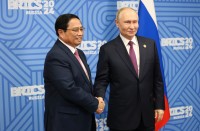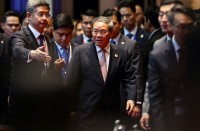Now attention has shifted to mega-regionals. There are three being negotiated: the TPP, RCEP and the EU-US Transatlantic Trade and Investment Partnership (TTIP). The TPP’s membership is 12 to date (US, Mexico, Canada, Chile, Peru, Australia, New Zealand, Japan, Singapore, Brunei, Malaysia and Vietnam). It started earlier than the others and is the closest to completion. RCEP’s members are the ASEAN 10 countries plus China, Japan, South Korea, India, Australia and New Zealand. Taken together, these three mega-regionals account for the bulk of world trade and GDP.
Mega-regionals potentially amplify the gains from trade liberalisation. If done cleanly and comprehensively, they would iron out distortions caused by multiple and overlapping FTAs among members (such as differing ROOs). With a bigger integrated economic space, they can reap economies of scale and spur technological innovation. This is particularly important for global supply chains. Regional production networks to serve global markets are the biggest drivers of productivity, employment and growth in international trade. They have a big stake in integrated regional and cross-regional markets. Still, mega-regionals are not ’multilateral’: they discriminate against non-members. That is a big potential source of disruption to global supply chains.
The TTIP and the TPP are the most ambitious mega-regionals. They cover markets for all goods, services, investment and government procurement, and go deep into regulatory disciplines — including on intellectual property, food safety and technical standards — and customs procedures. In the TPP, ‘twenty-first century’ innovations include rules to facilitate supply chains and e-commerce.
But there are major barriers that stand in the way of success.
Protectionist lobbies are big obstacles in several countries, including parts of agriculture and autos in the USA, agriculture in Japan, government procurement in Malaysia, and state-owned enterprises in Vietnam. The US insists on intellectual-property, public-health, labour and environmental standards, and ROO requirements that may impede market access for developing countries. And the Obama administration lacks Trade Promotion Authority from Congress, without which the TPP is unlikely to be concluded and ratified. The TTIP has also been slowed down by obstacles on both sides of the Atlantic.
RCEP looks the least ambitious. If it follows the pattern of intra-Asian FTAs, it will remove tariffs on about 90 per cent of goods over a fairly long timeframe. But it will have weak disciplines on non-tariff regulatory barriers that are the biggest obstacles to trade in the region. It might end up agglomerating the ‘noodle-bowl’ of FTAs among members rather than ironing out distortions among them. In such a scenario, RCEP will create little new trade and investment, and cause extra complications for global supply chains. But negotiations still have some way to go.
Much depends on US and Chinese leadership. President Obama’s leadership is needed to conclude a ‘high-quality, twenty-first century’ TPP — and open the door to eventual Chinese membership. But Obama has conspicuously failed to lead on international trade. Similarly, the Chinese leadership has been defensive on trade policy for almost a decade. But there are signs that China is becoming interested again in regional and global trade liberalisation. It will take Chinese leadership to inject more ambition into RCEP.
All ASEAN countries are in RCEP and four are in the TPP. What should they do on mega-regionals? First, they should push for ambitious agreements that are wide (with maximum sectoral coverage) and deep (with strong disciplines on regulatory barriers), with relatively simple ROOs and open accession clauses for non-members. Only this type of mega-regional is likely to create significant trade and investment, and facilitate the expansion of global supply chains. Second, they should back this up with intra-ASEAN measures, such as accelerating progress on the AEC and strengthening provisions in existing FTAs.
But it must be recognised that mega-regionals, and indeed other FTAs, are not a universal remedy. Political realities will inevitably dilute their ambition and quality. Given their gaps and distortions, they are unlikely to deliver the huge gains that many pundits predict. This applies to the TPP, RCEP and the AEC. The key policy implication that follows is that ASEAN countries should go as fast, wide and deep as possible withunilateral liberalisation. They should also ‘multilateralise’ preferences in existing FTAs as far as possible, that is, to extend them to non-members on a non-discriminatory basis. This is how ASEAN countries have liberalised and integrated into global supply chains in the past. That is unlikely to change in the future.
Razeen Sally is Associate Professor at the Lee Kuan Yew School of Public Policy, National University of Singapore.
See http://www.eastasiaforum.org/2014/09/10/is-bigger-better-for-asean-in-a-mega-regional-world/







